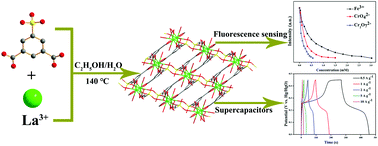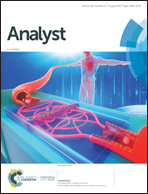A water-stable La-MOF with high fluorescence sensing and supercapacitive performances†
Abstract
A 3D lanthanide coordination polymer {[La(SIP)(H2O)3]·H2O}n (La-MOF) was synthesized successfully by the solvothermal reaction of La(NO3)3·6H2O and 5-sulfoisophthalic acid monosodium salt (NaH2SIP). In particular, two oxygen atoms of sulfate participate in the coordination, which is unusual in all the complexes. La-MOF was characterized by single-crystal X-ray diffraction, IR spectroscopy, powder X-ray diffraction, thermal-gravimetric analysis, and X-ray photoelectron spectroscopy. La-MOF shows excellent water stability and chemical stability in a broad pH range from 2 to 13. Moreover, the fluorescence and sensing properties of La-MOF were invsetigated in detail via its titration and cycling processes, revealing its highly efficient and selective quenching responses and good recyclability for the detection of Fe3+, Cr2O72− and CrO42− ions. In addition, La-MOF possesses an outstanding specific capacitance of 213 F g−1 at 0.5 A g−1. It still retains 92% of the original capacitance after 2000 cycles, exhibiting remarkable long-term cycling stability and reversibility; therefore, the electrode material based on La-MOF is a competitive and promising candidate for application in supercapacitors.

- This article is part of the themed collection: Analyst Recent HOT articles


 Please wait while we load your content...
Please wait while we load your content...